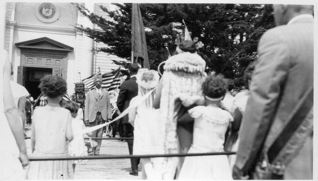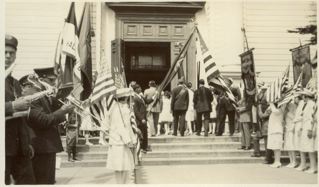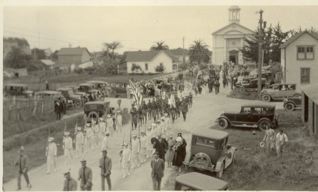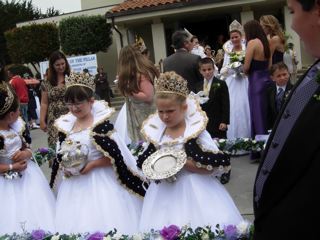1928 Chamarita, Half Moon Bay
History of the Coastside’s Beautiful Chamarita (5)
In the late 1890s the Brotherhood of the I.D.E.S. Society (The Society of Divine Holy Spirit) was organized and the first order of business was to raise funds for a new Crown to be owned by the Portuguese religious organization so that future Chamaritas would be assured of their precious symbol.
I.D.E.S founder Manuel Phillips Dutra became instrumental in the fundraising effort as he traveled in a horse drawn carriage throughout San Mateo County, collecting donations amounting to 400 silver dollars. The coins were melted down and molded into the society’s first crown–24-inches tall and weighing a hefty 30 pounds. This irreplaceable silver Crown has been used until the present day.
Dutra, who passed away in 1923, also donated land on Main Street in Half Moon Bay for construction of the I.D.E.S. building where future festivals would be held.
…to be continued…
History of the Coastside’s Beautiful Chamarita (4)
A band from Redwood City joined the festivities, playing marches. Along the route multi-colored Roman candles burned and there was the constant rat-a-tat-tat of small firecrackers.
Almost everybody in town attended the Catholic service, standing room only in the church. After the blessing of the Crown, services concluded, with the happy crowd bursting through the doors into the fresh Coastside air. The celebration continued just like in days of old. Tables, hundreds of feet in length, were loaded down with specially prepared “Chamarita” beef, baskets of bread and pitchers of wine.
Later all ages danced the Chamarita to the accompaniment of a guitarist. The Redwood City Band provided contemporary music until midnight. Everybody came to have a good time and they were not disappointed.
…to be continued…
History of the Coastside’s Beautiful Chamarita (3)
In the early days men led the procession as Mrs. Brown’s Crown was carried to the church and blessed by the priest. Afterward the festivities continued at Mrs. Brown’s home where the revered Crown was on display. In the afternoon a free delicious barbecue was enjoyed by all–followed by the Chamarita dance.
But two decades later, in 1893, the once simple affair had mushroomed into an event comparable to a Fourth of July celebration. Wearing a tiara, Miss Mary Freitas, that year’s festival queen, carried the Crown to the church. She headed up a torchlight procession, now 300 strong, marching from Mrs. Brown’s resident, just outside Half Moon Bay to the old Catholic Church in the center of town.
Miss Freitas represented Queen Isabel, and at her side stood several maids of honor, or “side queens,” all attired in wedding dress white and capes, carrying fragrant flower bouquets. As a Portuguese band played the home country’s “National Anthem,” the queen and her attendants walked the mile-long rfoute inside of four fabric-covered “rods” held by the younger girls.
..to be continued…
History of the Coastside’s Beautiful Chamarita (2)
To the Portuguese the Crown symbolized a sign of the Holy Ghost, an object of much veneration, and the people of the Azores vowed that they and their children would forever commemorate the day of the miracle: Pentecost Sunday.
No matter in what part of the world they made their home, there would always be an annual thanksgiving celebration honoring Queen Isabel for the sacrifice she made when offering her crown to the Holy Ghost. (Queen Isabel was canonized by Pope Urban VIII two centuries after her death in 1625).
A crown became the centerpiece of the Coastside celebration, beginning in Half Moon Bay in 1871. At first it was a very simple, dignified affair held at the home of Mrs. Rose Brown, the second Portuguese woman to arrive in Half Moon Bay in the mid-1800s. More significantly, she had brought with her from the Azores a delicately handmade gold colored replica of the original Crown. This precious symbol was handed down from one generation to the next.
…to be continued…
History of the Coastside’s Beautiful Chamarita (1)
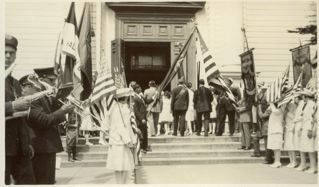 (Photo, 1928 “Holy Ghost Festival” outside the old Catholic Church in Half Moon Bay)
(Photo, 1928 “Holy Ghost Festival” outside the old Catholic Church in Half Moon Bay)
“Tradition cannot be purchased
Like a set of dishes,
Or a kitchen appliance.
Heritage must be preserved;
Often it must be rescued.
Or it must be created.”
–Mrs. Carolyn Cunha Granelli, 1921 Half Moon Bay “Chamarita” Festival Queen
The Chamarita’s warm atmosphere marked by spirited dancing, a colorful parade, sumptuous barbecue feast and auction have always been open to all comers.
But its heritage was born in tragedy.
The Holy Ghost Festival traces its origins to the 13th and 14th centuries when a violent earthquake and volcanic eruption shook the Azore Islands, located 1000 miles away from the Lisbon home of Portugal’s Queen Isabel. But nature was not finished with the small islands. Following the natural disasters there was drought, crop failure and finally a cruel famine that broke the people’s faith. In their desperation and suffering, they gathered together to pray to the Holy Ghost for help.
Their prayers were answered, and what followed was a miracle. A ship arrived at Port of Fayal on Pentecost Sunday, laden with food that fed the famished and restored the people’s faith.
When the good news reached Queen Isabel, she organized a solemn procession in honor of the Holy Ghost. Accompanied by her maids, the Queen carried her Crown through the streets of Lisbon to the Cathedral, placing it on the altar as an offering of thanksgiving for the favors the Holy Ghost had bestowed upon her people.
…to be continued…
Laura Azevedo Fell Madly In Love At HMB’s Chamarita
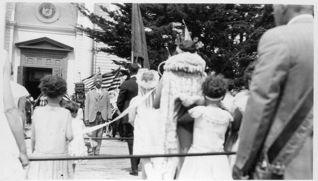 (Photo: 1928 Holy Ghost Festival, Half Moon Bay).
(Photo: 1928 Holy Ghost Festival, Half Moon Bay).
When Laura Canadas Azevedo was 15 years-old in 1920, the Half Moon Bay teenager looked forward to the annual Chamarita, an evening of dancing during the historic Holy Ghost Festival–a time of thanksgiving for the Coastside’s Portuguese community.
(Only on the Coastside is the event dubbed the “Chamarita–other Portuguese-American communities refer to the event as the “Holy Ghost Festival.”}
It was easy to understand that for Laura and her girlfriends, the dancing was the best part of the three-day religious celebration. The highlight for both young and old was the traditional Portguese folk dance called “the Chamarita.”
“Our families taught us to dance at the Chamarita,” Laura Azevedo told me.We would waltz, polka and do the fox trot. We would also do ‘schotises’. It’s a folk dance step,” she explained, eager to demonstrate. “It went, one, two, hop.”
Laura vividly recalled the pink Georgette dress she wore. “It was long waisted, beaded down the front and sleeveless with a scooped-out neckline.”
She stood among a sea of pretty Coastside girls, all chaperoned, waiting to be asked to dance–when a very good-looking fellow from nearby Higgins Canyon showed interest in her. His name was Fred Azevedo. He had never met Laura and asked a friend about the stunning young lady in the pink dress.
Laura felt lightheaded and flattered when Fred Azevedo slowly walked towards her.
“Fred asked me to dance,” she said, reliving that romantic, unforgettable moment. “We danced and danced and danced.”
Four years later the couple wed and moved from Half Moon Bay to Burlingame where Fred Azevedo operated the first Yellow Cab Company.
[In 2000, when I re-interviewed Laura Azevedo, she was 96-years-old]
2 Chamarita Queens: Angie Praeder & Minnie Valladao
In 1980 I was fortunate to meet and interview Half Moon Bay’s Angie Praeder and Minnie Valladao–it was for the documentary [“Mystery of Half Moon Bay”] that I was working on. The beautiful ladies, both former Chamarita Queens, were filmed, but unfortunately–the video was left on the cutting room floor, as they say. Boy, I wish that hadn’t happened.
Here’s what happened that day:
Close-up of Angie, close-up of Minnie
Angie Praeder (AP): I was born in 1899, here in Half Moon Bay. I was chosen (as Chamarita Queen) when I was 19-years-old.
AP: My father was a member of the society…it was just by luck…they drew the tickets and I was lucky enough to have my name drawn and that’s how I became queen.
AP: I wore a plain dress, just a plain dress and no crown. They didn’t wear a cape then either. I was really happy about it, seems like all the girls were. Everybody liked to be queen.
AP: The march started at the IDES Hall, down Main Street and into the Catholic Church. There was a mass and the crown was blessed.
AP: The barbecue was free. The farmers donated meat. Some donated wine, some bread.
AP: I can remember if that many people came who weren’t from Half Moon Bay. See, there weren’t that many cars then, so it was mostly just people from around here.
AP: And at that time we knew everybody. Now it’s so different. You don’t know half the people. It’s really the truth. It’s all outsiders.
AP: The crown was heavy, 30 pounds.
Minnie Valladao (MV): I was born in 1905. When I was chosen queen, I was 17-years-old–that was in 1922.
MV: The “little queen” does the same thing as the “big queen.”
MV: I wore a white dress, kind of fancy. Today the girls wear capes. Otherwise, there’s not too much different.
MV: I was proud to be queen. It was really an honor.
cutaways including Angie Praeder holding a photo of herself as the Chamarita Queen.

